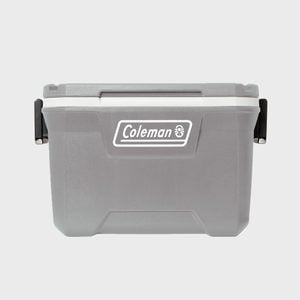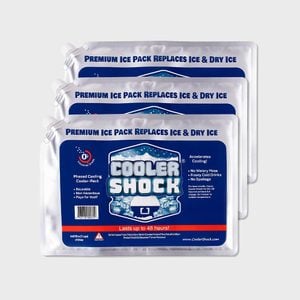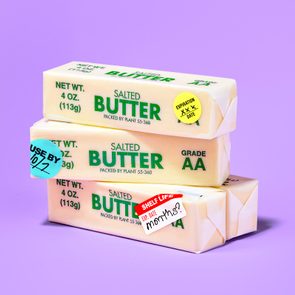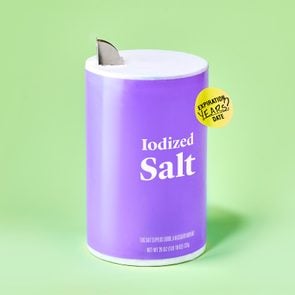How Long Will Food Last in the Fridge Without Power?
Updated: Feb. 29, 2024
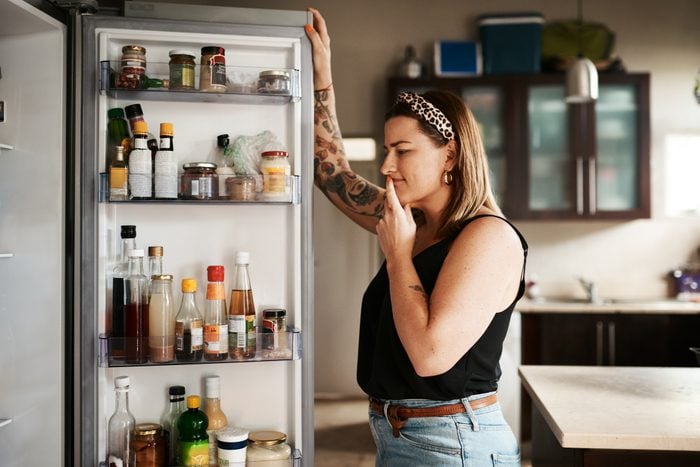
Follow these expert tips when there's a power outage, and you can save the food in your fridge—and save yourself from food poisoning
We’ve all experienced that dreaded moment when the power goes out—followed by the sobering realization that all the food in the fridge may be the next to go. Groceries are only getting more expensive, so during a power outage, you definitely want to save as much food as you can, whether it’s the milk and eggs you just picked up or the chicken you bought in bulk and froze. But, of course, it’s still essential to practice food safety and avoid food poisoning. So, how long can food last in the fridge without power?
It’s an increasingly important question. The Department of Energy recently found that weather-related power outages in the United States have increased by 67% since 2000. The intense thunderstorms, hurricanes and monsoons in the summer and the snowstorms and downed power lines in the winter are straining our power grids, and power outages can be inconvenient at best … and deadly at worst.
That’s why you need to be as informed and prepared as possible. Read on to find out how long can food last in the fridge without power, regardless of sell-by dates, and why stocking up on nonperishable foods and organizing your fridge properly are incredibly important too.
How to prep your fridge for a power outage
As Benjamin Franklin once said, an ounce of preparation is truly worth a pound of cure. It’s good practice to learn how to prepare for hurricane season, and if you know there will be inclement weather coming your way, the CDC advises stocking up on ice or making your own by freezing containers of water. Sticking these in your fridge and freezer will ultimately prolong how long a fridge will stay cold without power. Additionally, fill up coolers with ice and freezer packs beforehand, just in case you need to relocate the food in the fridge.
It’s also crucial to prep the fridge and freezer themselves. Don’t store milk and eggs in the refrigerator door, where the temperature is more likely to fluctuate; instead keep it on a more temperature-consistent shelf. Additionally, keep thermometers in both the fridge and freezer—after all, you won’t be able to read your appliance’s normally handy temperature gauges if the power’s out. The USDA’s Food Safety and Inspection Service (FSIS) says the proper refrigerator temperature should be 40 degrees or below, and the right freezer temperature should be 0 degrees or below, in order for food to keep well.
Finally, stock up on nonperishables like canned tuna, dried beans, peanut butter, pasta and nuts, as well as jugs of water, so that you can avoid opening the fridge to grab food when you or your family start getting hungry. FYI, you need to pay attention to the expiration date on bottled water too.
How long will food last without power?
Whether you’re prepared or the power outage comes as a surprise, the question still remains: How long can food last in the fridge without power? As long as food is kept at the proper temperature, the CDC says it can be kept for four hours in a refrigerator—but only if you don’t open the fridge (more on that later). How long will food last in the freezer without power depends on how full it is, as the more frozen items there are, the more they will regulate the cold temperatures and be less likely to thaw. Generally speaking, though, a good rule of thumb is 48 hours in a full freezer without power, or 24 hours in a half-full freezer.
Temperature is key here, as perishable foods can start to spoil or develop pathogenic bacteria like E. coli or salmonella faster than you think. According to the FSIS, “bacteria grow most rapidly in the range of temperatures between 40°F and 140°F, the ‘Danger Zone,’ some doubling in number in as little as 20 minutes. A refrigerator set at 40°F or below will protect most foods.”
Do some foods last longer than others?
Yes! How long food stays good in the fridge without power depends on the food itself, according to FoodSafety.gov. While fresh eggs kept in their shells can normally last up to three to five weeks in the fridge, and even expired eggs have a longer shelf life than their date suggests, exposing them to temps higher than 40 degrees for more than two hours will expose them to harmful bacteria. The same goes for milk, but how long milk lasts can be prolonged by placing it in the coldest part of the fridge. Raw meat should be wrapped securely, especially in the freezer, to prevent leakage and cross-contamination as it thaws, and even for cooked meat, it’s important to follow proper meat storage guidelines.
As for cheese, blocks of hard cheeses like cheddar or Parmesan will likely be fine during the power outage, and you can cut off any moldy parts and still eat the rest of the cheese. Soft cheeses like mozzarella, ricotta or cream cheese are more susceptible to bacteria, though, and will have a much shorter life span when the temperature goes higher than 40 degrees.
Luckily, vegetables and fruits (as long as they’re not cut), as well as high-acid foods such as dairy-free sauces, pickles or jellies or jams, should be fine in slightly higher temperatures.
How to keep your fridge (and freezer) cold without power
Once the power has already gone out, the biggest tip is to keep the doors shut, no matter how tempting it is to open them! Refrigerators are built to be insulated; any time you open the fridge or freezer, cold air molecules will rush out while warm air molecules rush in, and the temperatures will rise significantly.
However, if you didn’t prep your fridge beforehand, there are a few things you need to do immediately. “If your freezer is not full when the power fails, quickly group packages of food together so they can help keep each other cold,” says Barbara Brown, an associate professor of Nutritional Sciences at Oklahoma State University. “When you do that, be sure to separate meat and poultry so they are below other foods. That way, if they begin to thaw, their juices won’t drip onto ready-to-eat foods.” Just make sure to close the freezer or fridge immediately afterward.
After the four-hour mark, put the prepared ice in the fridge to maintain the cold temperature for a little longer until the power comes back, or start moving the food into those coolers. And while it may seem logical to put food outside during a snowstorm, the FSIS actually advises against this. Why? Outside temperatures can fluctuate, and your food can also be exposed to humidity and sunlight, other unsanitary conditions and animals.
If the power is still not back on after four hours, and you notice the temperature in your fridge starts creeping higher than 40 degrees, you can always light some candles, throw a mini-blackout party and cook a feast while you can—as long as your food is still safe to eat, of course.
What to throw out after a power outage
Now that we’ve answered how long can food last in the fridge without power, you may be wondering what foods are actually safe to eat after the four-hour mark. Are some still OK, and is there any wiggle room? The short answer is yes, some of the food may be salvageable. That said, there are a few general rules you should follow, and you should also be familiar with the telltale signs that food has gone bad.
The CDC recommends discarding refrigerated perishable food such as meat, poultry, fish, eggs and soft cheeses after four hours without power. You can, however, check the temperature of each of those food items individually to see if it’s higher than 40 degrees.
If you’re someone who has to see it to believe it, check eggs for sliminess or a powdery residue or, when you crack them open, a sulfury or tangy smell. It’s very easy to tell if milk has gone bad, but make sure to smell it first before you pour it into your cereal or coffee. Plant-based milks also go bad, but it’s harder to tell if your favorite oat milk or almond milk is spoiled just by smelling it, so pour a little bit into a separate container; spoiled plant-based milk tends to have a chunky, uneven consistency.
The most important thing? Don’t taste-test! The CDC and FSIS both strongly advise against tasting food to see if it’s gone bad. If you’re still not sure despite a sour smell, discoloration or strange texture, “when in doubt, throw it out!” Ultimately, you’ll save more money by avoiding a hefty hospital bill than by trying to save on potentially spoiled food. While we’re on the subject, never eat these foods past their expiration dates.
Get Reader’s Digest’s Read Up newsletter for more food, humor, cleaning, travel, tech and fun facts all week long.
Sources:
- Climate Central: “Power OFF: Extreme Weather and Power Outages”
- CDC: “Food Safety for Power Outages”
- FSIS: “Avoid Foodborne Illness During Temporary Power Outages”
- FSIS: “Refrigeration & Food Safety”
- FoodSafety.gov: “Food Safety During Power Outage”
- Barbara Brown, food specialist and associate professor of Nutritional Sciences at Oklahoma State University
- FSIS: “USDA Offers Food Safety Tips for Areas Affected by Winter Storms”




















